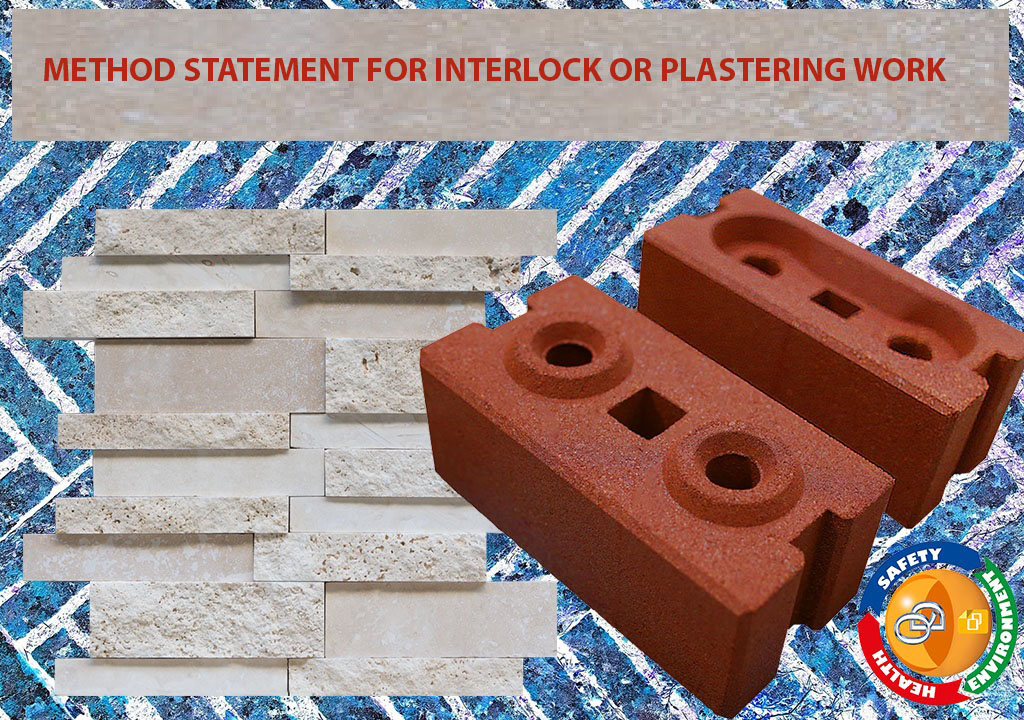 |
| METHOD STATEMENT FOR INTERLOCK OR PLASTERING WORK |
PURPOSE
To make sure that the installation and erection of Interlock tiles and related activities are executed safely and following the contract requirements and that all quality assurance/control activities are conducted systematically.
RESPONSIBILITIES
- The project Manager/Engineer shall be responsible for the overall implementation of this installation procedure.
- Site Engineer / Site Supervisor / Surveyor/ Foreman shall ensure that plastering works are carried out as per specification, drawings, and method statements.
- QA/QC Engineer along with QC Engineer shall ensure that works are carried out as per the project’s requirements. He is responsible for the implementation of related Quality Assurance/Quality Control works as documented in the Quality procedure and Quality plan for plastering/interlock activity. QA/QC Engineer shall also make coordinate and communicate with the site laboratory for testing of materials/chemicals and or substances related to plaster/interlock works.
- The HSE Officer along with the safety officer shall ensure the implementation of all safety procedures, and safety measures related to the nature of works being carried out and following the HSE Plan.
EQUIPMENT
The equipment involved in Acoustic works is listed below:
- Interlock cutter
- Plate compactor
- Wheel borrows
- Meter
- Hand tools
- Carpentry tools
SAFETY HAZARDS AND PREVENTIVE MEASURES
HAZARDS
1-Dust
Dust entering the eyes and breathing system
CONTROL MEASURES
Use PPE- Mask, Goggles
2-Heat
Person working hot Environment continuously.
CONTROL MEASURES
- Provision of adequate cool drinking water.
- Provision of shade.
- Appropriate time adjustments in the extremely hot circumstances-
- Not working during extremely hot hours, particularly in external areas
3-Noise
Prolonged exposure to noise
CONTROL MEASURES
Use Proper Personal Protective Equipment (PPE)- exposure to a minimum
General
- Submittals,
- Fabrication and manufacture,
- Product delivery, storage, materials
- Shall be as SOR item’s description and FME recommendations.
- Work Permit, materials, and or substance approvals shall be secured from
- MANAGER/COMPANY. All mandatory precautions shall be taken.
PROCEDURE
Preparation
- Before interlock work starts, make sure that the sub-grade is compacted when the area is above the sub-base shall be compacted with a vibratory roller, and the size of the roller shall be suitable for the area where it could maneuver and move back and forth.
- Once completed and fulfilled the specification requirement for completion and approved by the project/site
- Engineer, the base course shall then be placed/applied above the completed/compacted sub-base but ensure that the thickness of the bases/primal is as per the approved drawing and required standards and quality of work.
- In the areas where there is kerbs stone, the blinding shall be constructed first to serve as the base but make sure it shall be as per drawing.
- The significance of pre-installation of kerbs stone is to save you the migration or dis-alignment of interlock paintings or block mendacity interest/work, and it will serve as a reference line or level for the paintings that is being executed for interlock or plastering.
- After completion of the primary course, the black sand shall be laid on it of 50 millimeters thick. There are cases where the bedding is mixed with cement to adhere to cohesiveness but it will be as per specification requirements.
Installation method
- The minimum thickness of the interlock shall be 60 mm with various colours.
- Approved material, chemicals, and or substances for interlock or paving block shall be utilized in the installation accordingly.
- The aspects, dimensions, thickness, and design for the interlock and plastering work shall be as per the approved shop drawing and required standards and quality.
- Land surveying shall be made to mark the required levels, alignments, and setting outlines for interlock as per the approved drawing.
- Once the entire location is completed, excellent sand can then lay on the mounted interlock or paving block.
- The Sand for interlock/plastering paintings can be unfolded flippantly on the complete region.
- A plate compactor will be used to compact the set-up interlock or paving blocks.
- Once compacted, right house responsibilities might be followed to do away with all extra sand broken portions, and unique waste.
- Inspection requests for the interlock/plastering paintings will then be submitted to the Project Engineer for approval.